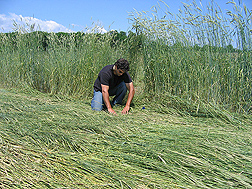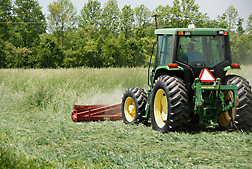Rolling Rye
Guidelines Help Determine When’s Best
|
|
Cereal rye is increasingly being used as a cover crop because it prevents erosion, helps the soil retain nutrients, and reduces the need to till the soil. Organic farmers also use cereal rye to help control weeds. When used as a cover crop, rye is planted in the fall, killed in the spring, and left to decompose. Then, soybeans and other cash crops are seeded through the dried-up plant residue, which forms a surface mulch.
In some cases, farmers are opting to use a tool known as a “roller/crimper,” which can flatten and kill an actively growing field of rye in a single pass. There are several designs, but most involve some type of rolling, paddle-wheel-like cylinder that attaches to a tractor and barrels over a field, tamping and crimping the rye into a smooth mat to kill it. The technology has been used for at least 15 years in small farms in South America and is slowly catching on in the United States, according to Steven Mirsky, an ecologist in the Sustainable Agricultural Systems Laboratory in Beltsville, Maryland.
Mirsky estimates that rolling a field of rye uses 10 times less energy than mowing. Rolling is also faster and only needs to be done once a season. And while mowing leaves bits of rye in the field that decompose quickly, rolling leaves rye residue intact, forming a thick mat that provides better weed suppression.
|
|
Rollers present their own challenges. If you roll the rye too early in the spring, it won’t die off, but will grow back and take up moisture from the soil, essentially competing with the cash crop and diminishing yields.
But Mirsky and other ARS researchers hope to encourage more U.S. farmers to adopt the technology because of the potential benefits to soil quality and the reduced energy and production costs. They are studying ways to maximize the benefits of a roller, and with the help of a computer model, they are developing guidelines for predicting the best times for growers to use rollers to kill their rye. The guidelines are based on regional weather patterns over the course of a growing season, and their hope is that the guidelines will be used nationwide.
Mirsky planted two common types of rye, Aroostook and Wheeler, in Pennsylvania test plots, at six 10-day intervals, in two successive falls. He used a 1.5-ton steel crimper, constructed by colleagues at Pennsylvania State University, to flatten it out at 10-day intervals each spring. He then visually rated the rye’s regrowth on a 0-to-100 scale, 6 weeks after each plot was flattened.
The results show that the best time to roll the rye is when it reaches 50 to 75 percent of its flowering state, because that is when rolling consistently kills the cover crop. The results, published in Agronomy Journal, were consistent for both varieties of rye, and it didn’t matter exactly when in the fall the rye was planted or when in the spring it was rolled, as long as the plants had reached 50 to 75 percent of their flowering state.
The computer simulations developed as part of the project also adequately predicted the best dates for growers to roll their rye, with those dates timed around regional heating and cooling patterns and how early or late in the fall the rye is planted.
They are working toward a Web-based tool that growers around the country will be able to use, possibly by typing in ZIP Codes or other information that identifies the locations of their fields.—By Dennis O'Brien, Agricultural Research Service Information Staff.
This research is part of Crop Protection and Quarantine, an ARS national program (#304) described at www.nps.ars.usda.gov.
Steven Mirsky is with the USDA-ARS Sustainable Agricultural Systems Laboratory, 10300 Baltimore Ave.,Beltsville, MD 20705-2350; (301) 504-5324.
"Rolling Rye: Guidelines Help Determine When’s Best" was published in the November/December 2010 issue of Agricultural Research magazine.









